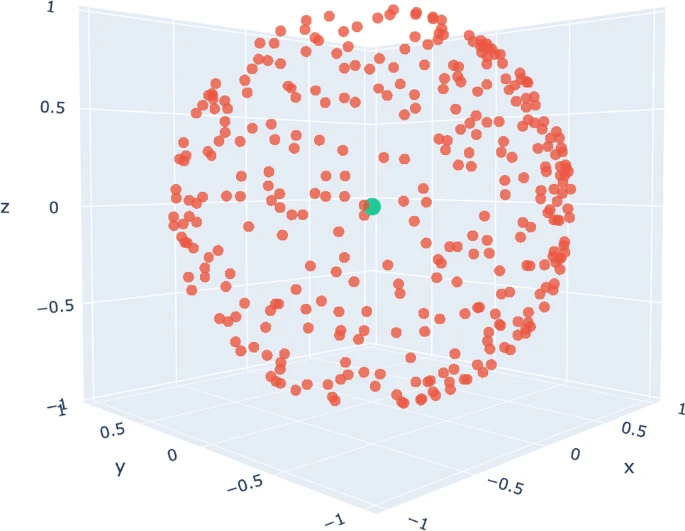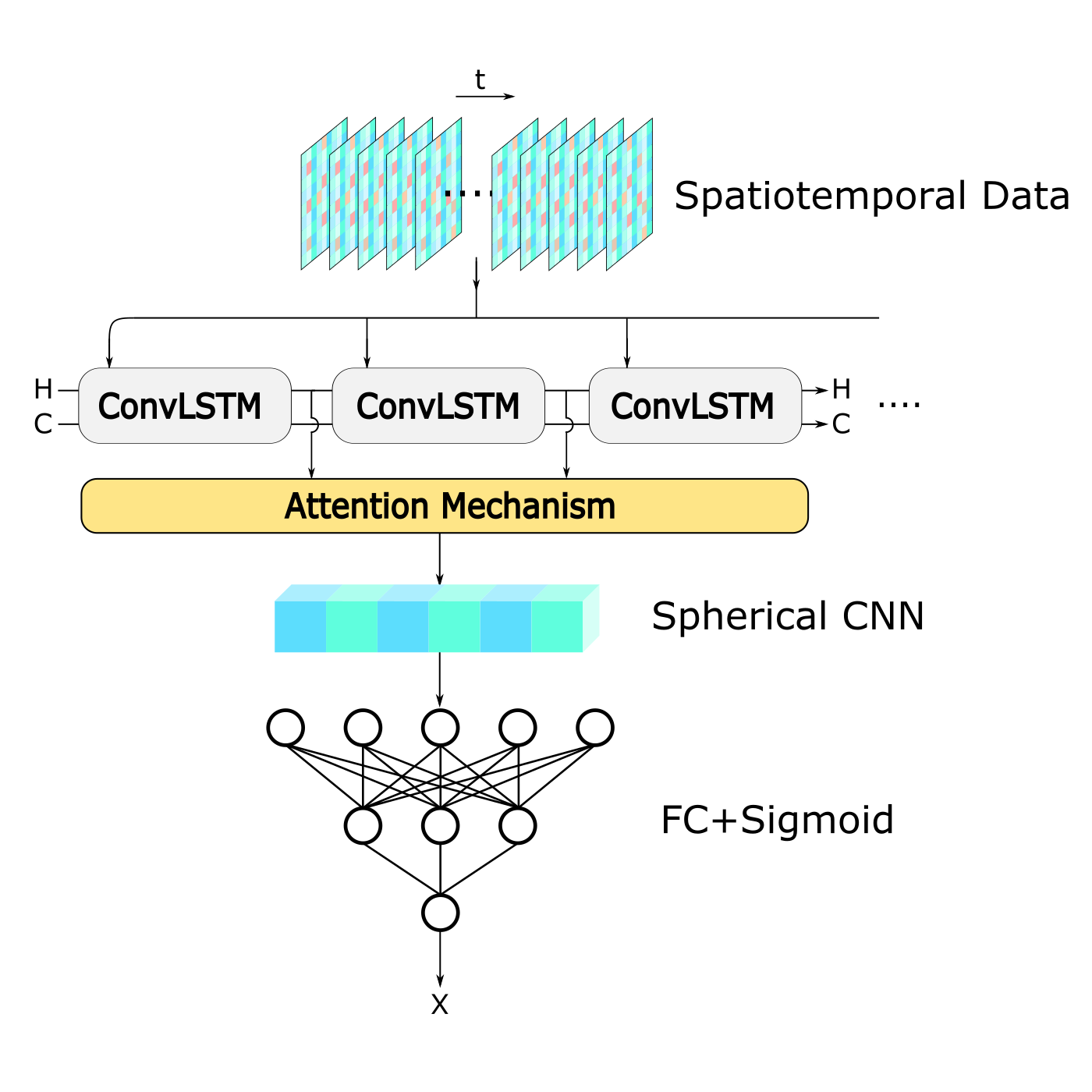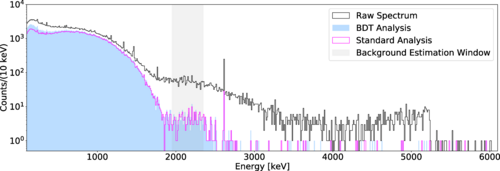Selected Papers and Conference Proceedings
RESuM: A Rare Event Surrogate Model for Physics Detector Design
Ann-Kathrin Schuetz, A.W.P. Poon, Aobo Li
The experimental discovery of neutrinoless double-beta decay (NLDBD) would answer one of the most important questions in physics: Why is there more matter than antimatter in our universe? To maximize the chances of discovery, NLDBD experiments must optimize their detector designs to minimize the probability of background events contaminating the detector. Given that this probability is inherently low, design optimization either requires extremely costly simulations to generate sufficient background counts or contending with significant variance. In this work, we formalize this dilemma as a Rare Event Design (RED) problem: identifying optimal design parameters when the design metric to be minimized is inherently small. We then designed the Rare Event Surrogate Model (RESuM) for physics detector design optimization under RED conditions. RESuM uses a pre-trained Conditional Neural Process (CNP) model to incorporate additional prior knowledge into a Multi-Fidelity Gaussian Process model. We applied RESuM to optimize neutron shielding designs for the LEGEND NLDBD experiment, identifying an optimal design that reduces the neutron background by % while using only 3.3% of the computational resources compared to traditional methods. Given the prevalence of RED problems in other fields of physical sciences, especially in rare-event searches, the RESuM algorithm has broad potential for accelerating simulation-intensive applications.
ICLR 2025 SpotlightTIDMAD: Time Series Dataset for Discovering Dark Matter with AI Denoising
J. T. Fry, Lindley Winslow, Xinyi Hope Fu, Zhenghao Fu, Kaliroe M. W. Pappas, Aobo Li
Dark matter makes up approximately 85% of total matter in our universe, yet it has never been directly observed in any laboratory on Earth. The origin of dark matter is one of the most important questions in contemporary physics, and a convincing detection of dark matter would be a Nobel-Prize-level breakthrough in fundamental science. The ABRACADABRA experiment was specifically designed to search for dark matter. Although it has not yet made a discovery, ABRACADABRA has produced several dark matter search results widely endorsed by the physics community. The experiment generates ultra-long time-series data at a rate of 10 million samples per second, where the dark matter signal would manifest itself as a sinusoidal oscillation mode within the ultra-long time series. In this paper, we present the TIDMAD -- a comprehensive data release from the ABRACADABRA experiment including three key components: an ultra-long time series dataset divided into training, validation, and science subsets; a carefully-designed denoising score for direct model benchmarking; and a complete analysis framework which produces a community-standard dark matter search result suitable for publication as a physics paper. This data release enables core AI algorithms to extract the signal and produce real physics results thereby advancing fundamental science.
Under SubmissionGenerative models for simulation of KamLAND-Zen
Zhenghao Fu, Christopher Grant, Dominika M. Krawiec, Aobo Li, Lindley A. Winslow
The next generation of searches for neutrinoless double beta decay () are poised to answer deep questions on the nature of neutrinos and the source of the Universe’s matter–antimatter asymmetry. They will be looking for event rates of less than one event per ton of instrumented isotope per year. To claim discovery, accurate and efficient simulations of detector events that mimic is critical. Traditional Monte Carlo (MC) simulations can be supplemented by machine-learning-based generative models. This work describes the performance of generative models that we designed for monolithic liquid scintillator detectors like KamLAND to produce accurate simulation data without a predefined physics model. We present their current ability to recover low-level features and perform interpolation. In the future, the results of these generative models can be used to improve event classification and background rejection by providing high-quality abundant generated data.
The European Physical Journal CSearch for the Majorana Nature of Neutrinos in the Inverted Mass Ordering Region with KamLAND-Zen
S. Abe et al. (KamLAND-Zen Collaboration)
The KamLAND-Zen experiment has provided stringent constraints on the neutrinoless double-beta (0νββ) decay half-life in 136Xe using a xenon-loaded liquid scintillator. We report an improved search using an upgraded detector with almost double the amount of xenon and an ultralow radioactivity container, corresponding to an exposure of 970 kg-yr of 136Xe. These new data provide valuable insight into backgrounds, especially from cosmic muon spallation of xenon, and have required the use of novel background rejection techniques. We obtain a lower limit for the 0νββ decay half-life of T1/2 > 2.3×1026 yr at 90% C.L., corresponding to upper limits on the effective Majorana neutrino mass of 36–156 meV using commonly adopted nuclear matrix element calculations.
Phys. Rev. Lett. (Editor's Suggestion, Featured in Physics)KamNet: An integrated spatiotemporal deep neural network for rare event searches in KamLAND-Zen
A. Li, Z. Fu, C. Grant, H. Ozaki, I. Shimizu, H. Song, A. Takeuchi, and L. A. Winslow
Rare event searches allow us to search for new physics at energy scales inaccessible with other means by leveraging specialized large-mass detectors. Machine learning provides a new tool to maximize the information provided by these detectors. The information is sparse, which forces these algorithms to start from the lowest level data and exploit all symmetries in the detector to produce results. In this work we present KamNet, which harnesses breakthroughs in geometric deep learning and spatiotemporal data analysis to maximize the physics reach of KamLAND-Zen, a kiloton scale spherical liquid scintillator detector searching for 0νββ. Using a simplified background model for KamLAND, we show that KamNet outperforms a conventional convolutional neural network (CNN) on benchmarking Monte Carlo simulations with an increasing level of robustness. Using simulated data, we then demonstrate KamNet's ability to increase KamLAND-Zen's sensitivity to 0νββ and 2νββ decay to excited states. A key component of this work is the addition of an attention mechanism to elucidate the underlying physics KamNet is using for the background rejection.
Phys. Rev. C (Editor's Suggestion)Final Result of the Majorana Demonstrator’s Search for Neutrinoless Double-β Decay in 76Ge
I. J. Arnquist et al. (Majorana Collaboration)
The Majorana Demonstrator searched for neutrinoless double-β decay (0νββ) of 76Ge using modular arrays of high-purity Ge detectors operated in vacuum cryostats in a low-background shield. The arrays operated with up to 40.4 kg of detectors (27.2 kg enriched to ∼88% in 76Ge). From these measurements, the Demonstrator has accumulated 64.5 kg yr of enriched active exposure. With a world-leading energy resolution of 2.52 keV FWHM at the 2039 keV Qββ (0.12%), we set a half-life limit of 0νββ in 76Ge at T1/2 > 8.3×1025 yr (90% C.L.). This provides a range of upper limits on mββ of (113–269) meV (90% C.L.), depending on the choice of nuclear matrix elements.
Phys. Rev. Lett. (Editor's Suggestion)Interpretable boosted-decision-tree analysis for the Majorana Demonstrator
I. J. Arnquist et al. (Majorana Collaboration)
The Majorana Demonstrator is a leading experiment searching for neutrinoless double-beta decay with high purity germanium (HPGe) detectors. Machine learning provides a new way to maximize the amount of information provided by these detectors, but the data-driven nature makes it less interpretable compared to traditional analysis. An interpretability study reveals the machine's decision-making logic, allowing us to learn from the machine to feed back to the traditional analysis. In this work, we present the first machine learning analysis of the data from the Majorana Demonstrator; this is also the first interpretable machine learning analysis of any germanium detector experiment. Two gradient boosted decision tree models are trained to learn from the data, and a game-theory-based model interpretability study is conducted to understand the origin of the classification power. By learning from data, this analysis recognizes the correlations among reconstruction parameters to further enhance the background rejection performance. By learning from the machine, this analysis reveals the importance of new background categories to reciprocally benefit the standard Majorana analysis. This model is highly compatible with next-generation germanium detector experiments like LEGEND since it can be simultaneously trained on a large number of detectors.
Phys. Rev. CAd-hoc Pulse Shape Simulation using Cyclic Positional U-Net
A. Li, J. Gruszko, B. Bos, T. Caldwell, E. León, J. Wilkerson
High-Purity Germanium~(HPGe) detectors have been a key technology for rare-event searches, such as neutrinoless double-beta decay and dark matter searches, for many decades. Pulse shape simulation is pivotal to improving the physics reach of these experiments. In this work, we propose a Cyclic Positional U-Net to achieve ad-hoc pulse shape simulations with high precision and low latency. Taking the transfer learning approach, CPU-Net translates simulated pulses to detector pulses such that they are indistinguishable. We demonstrate CPU-Net's performance on data taken from a local HPGe detector.
NeurIPS 2022 ML4PS Workshop Outstanding PaperSuppression of Cosmic Muon Spallation Backgrounds in Liquid Scintillator Detectors Using Convolutional Neural Networks
A. Li, A. Elagin, S. Fraker, C. Grant, L. Winslow
Cosmic muon spallation backgrounds are ubiquitous in low-background experiments. For liquid scintillator-based experiments searching for neutrinoless double-beta decay, the spallation product 10C is an important background in the region of interest between 2–3 MeV and determines the depth requirement for the experiment. We have developed an algorithm based on a convolutional neural network (CNN) that uses the temporal and spatial correlations in light emissions to identify 10C background events. Using a simple Monte Carlo simulation of a monolithic liquid scintillator detector like KamLAND, we find that the algorithm is capable of identifying 61.6% of the 10C at 90% signal acceptance, with a total uncertainty of 2.7%. A detector with perfect light collection can identify 98.2% at 90% signal acceptance. The algorithm is independent of vertex and energy reconstruction, so it is complementary to other frequently-used methods and can be expanded to other background sources. This work forms the foundation for more in depth studies of detector-dependent effects and more advanced CNN-based algorithms.
Nucl. Inst. Meth. A






